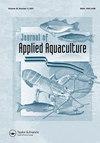Co-feeding schemes affect survival, growth, and development in the larviculture of the Striped cleaner shrimp Lysmata amboinensis (de Mann, 1888)
IF 0.8
Q3 FISHERIES
引用次数: 0
Abstract
ABSTRACT Improving larval nutrition is a key aspect to enhancing larval survival and shortening the larval cycle of the cleaner shrimp Lysmata amboinensis, the most traded shrimp species in the marine ornamental industry. A 30-day feeding trial was conducted in order to investigate the effect of the different feeding schemes: AT- Enriched Artemia meta-nauplii + Thalassiosira pseudonana; RAT- Enriched rotifers + enriched Artemia + T. pseudonana; CAT- Apocyclops panamensis copepodites + Enriched Artemia + T. pseudonana; STR- under starvation, upon growth, survival, and development of L. amboinensis larvae. Larvae in the CAT and STR treatments survived for over 3 days, however, total mortality occurred before day 6 in both treatments, whereas in RAT, larvae had an average survival (± SD) of 68.3 ± 12.5% by the end of the trial and those in AT showed a survival of 30.0 ± 5.0%. Development rate was also higher in RAT, where 44.3 ± 13.8% of the larvae were able to reach the zoea X stage by the end of the experiment. Among the larvae in AT, 88.5 ± 10.3% of them were at the zoea IX stage and a small percentage of the larvae were still at the zoea VIII stage on day 30. Growth in AT (2.02 ± 0.33 mm) was lower than in RAT (3.50 ± 0.26 mm). These results suggest that a diverse diet based on a combination of rotifers, Artemia and the microalgae T. pseudonana promotes a satisfactory performance of early to intermediate L. amboinensis zoea stages.共同饲养方案影响条纹清洁虾Lysmata amboinensis的幼虫养殖中的存活、生长和发育(de Mann,1888)
摘要作为海洋观赏产业中交易量最大的虾类,改善幼虾营养是提高幼虾存活率和缩短幼虾周期的关键。通过30 d的饲养试验,研究了不同饲养方案的效果:AT-富集的阿耳特蒿+假海藻;RAT-富集轮虫+富集蒿+假单胞菌;CAT- Apocyclops panamensis copepodites +富集蒿+ T. pseudonana;STR-在饥饿条件下,对L. amboinensis幼虫生长、存活和发育的影响。CAT和STR处理的幼虫存活时间均在3 d以上,但总死亡时间均在第6天之前,而RAT处理的幼虫平均存活率(±SD)为68.3±12.5%,AT处理的存活率为30.0±5.0%。大鼠的发育率也较高,实验结束时,有44.3±13.8%的幼虫能达到X期。AT期幼虫中,88.5±10.3%的幼虫处于第9期,在第30天仍有小部分幼虫处于第8期。AT组的生长(2.02±0.33 mm)低于RAT组(3.50±0.26 mm)。这些结果表明,以轮虫、蒿和微藻组合为基础的多样化饮食促进了早期到中期amboinensis zoea阶段令人满意的表现。
本文章由计算机程序翻译,如有差异,请以英文原文为准。
求助全文
约1分钟内获得全文
求助全文
来源期刊

Journal of Applied Aquaculture
Environmental Science-Ecology
CiteScore
3.20
自引率
0.00%
发文量
38
期刊介绍:
The Journal of Applied Aquaculture is a platform for the sharing of practical information needed by researchers to meet the needs of investors, farm managers, extension agents and policy makers working to adapt aquaculture theory to achieve economic and food security objectives in the real world. The journal emphasizes multi-disciplinary research and case studies that propose financially and logistically viable solutions to observable problems.
 求助内容:
求助内容: 应助结果提醒方式:
应助结果提醒方式:


